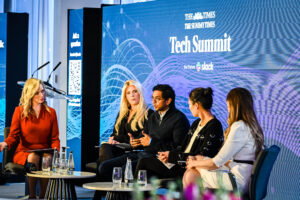We marketers often fall for our own tricks, chasing breathlessly after the newest, shiniest thing.
Right now, that means the metaverse. NFTs, digital stores, designer clothes for little legless avatars: it's Zuck's world, but we get to pay for it.
This kind of tunnel vision reminds me of a therapist friend who often asks his patients to look around and focus on everything red. After a minute of intense focus, he asks them to shut their eyes - and recount everything that was blue.
When focusing on one thing exclusively, like how cool the metaverse is, we miss other valuable stuff - like what traditional media can do for our brand. Because there is plenty they still do better than anything else.
Advertising's multi-media challenge
Print has had its challenges. UK titles have seen large-scale reductions in advertising spend, as Accenture notes.
But print has not faced industrial challenges alone. Digital advertising has had a rough time, too. When Apple reduced tracking identifiers and increased privacy controls in apps, it blew a $10bn hole in Meta's 2022 revenue forecast and caused a 23% dip in its share price.
Big digital companies – from Snap to Peloton – reported significant impacts, whilst the average mobile advertiser's ROI fell by 38% and mobile ad spend fell 25%, according to a mobile measurement firm.
But by late 2021, total advertising spend, as well as that of national and regional newsbrands, bounced back, while The Guardian, Financial Times, The Economist and The Times/Sunday Times all increased digital subscriber numbers.
Newsbrands state their case
And there's more good news....
Print complements digital
Print advertising still elicits more trust, credibility and brand recall than an online placement.
Print advertising is considered the most trustworthy channel, more than social media on just 19%, according to a YouGov study.
Which explains why global brands such as Google, YouTube and MasterCard have all invested in print campaigns in 2022.
Luxury likes paper
Print prestige also explains continued spend by beauty, fashion and leisure brands in the glossies.
Print enjoys higher brand recall than digital (77% vs. 46%, according to RAMetrics), which is why luxury brands such as Dior, Bentley, Rolex and Patek Phillipe favour print for flagship campaigns.
Restoring attention
Even younger consumers know print is a great way to stay mindfully informed in the content cacaphony. Generation-Z consumers spend more time reading newspapers and magazines without interruption than they do social media, websites and blogs, according to an MNI survey.
Similarly, a study by Canada Post and TrueImpact found direct mail requires 21% less cognitive effort to process than does digital media, with 70% higher recall. Print, then, commands more focused attention.
Publishing as platform
So, there's a lot of blue stuff out there if you don't get distracted by the red. The moral is not to abandon all we've learned in our rush to follow the new.
The metaverse may yet provide the most effective advertising channels ever invented.
But, meanwhile, there are channels that can deliver proven results, especially if you use them in innovative ways.
The smart approach is to embrace dynamic testing.
- Rely on trusted channels whilst testing new ones in different permutations.
- Continually optimize your mix while you test what works for your brand and audience.
It has been repeatedly shown how combining print and digital channels in a campaign multiplies effectiveness.
Just as vinyl has found a new lease of life in a world full of streaming, so there's a place for traditional media in a metaverse world.
It's about using the best tools for your brand, keeping an open mind and an eye out for the blue stuff, even when the red stuff is flashing so very brightly.










